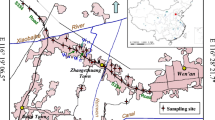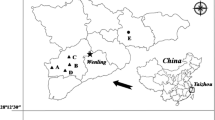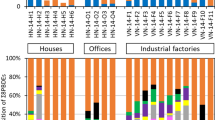Abstract
Workplace exposure to persistent organic pollutants is a concern for human health. This study examined the presence of polybrominated diphenyl ethers (PBDEs) and polychlorinated biphenyls (PCBs) in the indoor dust from two major e-waste recycling sites and a university electronic equipment repair workshop in Durban, South Africa, in order to evaluate the implication of dust for occupational exposure. The mean ∑(n = 8)PBDEs and ∑(n = 3)PCBs were 20,094 and 235 ng g−1, respectively. The levels of PBDEs and PCBs obtained in one of the recycling sites (123–27,530 and 161–593 ng g−1) were significantly higher than the levels obtained (91–7686 and <DL–42 ng g−1, respectively) in the same site after site cleanup/maintenance. Occupational exposure was assessed for different exposure scenarios by using the 5th and 95th percentile, and the median and mean concentrations measured at the sites. By assuming a mean and a high dust intake rate, the average and 95th percentile daily exposure doses (∑DED/ng kg−1 bw day−1) of PBDEs were 3.98, 8.52 and 7.58, 16.19, respectively, and of PCBs were 0.047, 0.094 and 0.089, 0.179, respectively. The ∑DEDs of PBDEs and PCBs were lower than the reference (RfD) values for BDE 47, BDE 99, BDE 153 and BDE 209, and Aroclor 1254 and 1016. Nevertheless, continual exposure to high levels of these pollutants is a concern; but as shown, the exposure can be significantly reduced if the e-waste facilities are cleaned thoroughly regularly.





Similar content being viewed by others
References
Abafe OA, Martincigh BS (2014) Polybrominated diphenyl ethers and polychlorinated biphenyls in indoor dust in Durban, South Africa. Indoor Air. doi:10.1111/ina.12168
Ali N, Harrad S, Goosey E, Neels H, Covaci A (2011a) “Novel” brominated flame retardants in Belgian and UK indoor dust: implications for human exposure. Chemosphere 83:1360–1365
Ali N, Harrad S, Muenhor D, Neels H, Covaci A (2011b) Analytical characteristics and determination of major novel brominated flame retardants (NBFRs) in indoor dust. Anal Bioanal Chem 400:3073–3083
Ali N, Van den Eede N, Dirtu AC, Neels H, Covaci A (2011c) Assessment of human exposure to indoor organic contaminants via dust ingestion in Pakistan. Indoor Air 22:200–211
Ali N, Ali L, Mehdi T, Dirtu AC, Al-Shammari F, Neels H, Covaci A (2013) Levels and profiles of organochlorines and flame retardants in car and house dust from Kuwait and Pakistan: implication for human exposure via dust ingestion. Environ Int 55:62–70
Brouwer A, Ahlborg UG, van Leeuwen RFX, Feeley MM (1998) Report of the WHO working group on the assessment of health risks for human infants from exposure to PCDDS, PCDFS and PCBS. Chemosphere 37:1627–1643
Bunhu T (2005) M.Sc. Dissertation, University of KwaZulu-Natal, Durban, South Africa
Darnerud PO, Aune M, Larsson L, Lignell S, Mutshatshi T, Okonkwo J, Botha B, Agyei N (2011) Levels of brominated flame retardants and other pesistent organic pollutants in breast milk samples from Limpopo province, South Africa. Sci Total Environ 409:4048–4053
Gleit A (1985) Estimation for small normal data sets with detection limits. Environ Sci Technol 19:1201–1206
Harrad S, Ibarra C, Abdallah MA-E, Boon R, Neels H, Covaci A (2008) Concentrations of brominated flame retardants in dust from United Kingdom cars, homes, and offices: causes of variability and implications for human exposure. Environ Int 34:1170–1175
Hwang H-M, Park E-K, Young TM, Hammock BD (2008) Occurrence of endocrine-disrupting chemicals in indoor dust. Sci Total Environ 404:26–35
Johnson-Restrepo B, Kannan K (2009) An assessment of sources and pathways of human exposure to polybrominated diphenyl ethers in the United States. Chemosphere 76:542–548
Jones-Otazo HA, Clarke JP, Diamond ML, Archbold JA, Ferguson G, Harner T, Richardson GM, Ryan JJ, Wilford B (2005) Is house dust the missing exposure pathway for PBDEs? An analysis of the urban fate and human exposure to PBDEs. Environ Sci Technol 39:5121–5130
Kefeni KK, Okonkwo JO (2012) Analysis of major congeners of polybromobiphenyls and polybromodiphenyl ethers in office dust using high resolution gas chromatography–mass spectrometry. Chemosphere 87:1070–1075
Kodavanti PRS, Curras-Collazo MC (2010) Neuroendocrine actions of organohalogens: thyroid hormones, arginine vasopressin, and neuroplasticity. Front Neuroendocrinol 31:479–496
Król S, Zabiegała B, Namieśnik J (2012) Determination of polybrominated diphenyl ethers in house dust using standard addition method and gas chromatography with electron capture and mass spectrometric detection. J Chromatogr A 1249:201–214
Labunska I, Harrad S, Santillo D, Johnston P, Brigden K (2013) Levels and distribution of polybrominated diphenyl ethers in soil, sediment and dust samples collected from various electronic waste recycling sites within Guiyu town, southern China. Environ Sci Process Impacts 15:503–511
Leung AOW, Zheng J, Yu CK, Liu WK, Wong CKC, Cai Z, Wong MH (2011) Polybrominated diphenyl ethers and polychlorinated dibenzo-p-dioxins and dibenzofurans in surface dust at an e-waste processing site in Southeast China. Environ Sci Technol 45:5775–5782
Liberda EN, Wainman BC, LeBlanc A, Dumas P, Martin I, Tsuji LJS (2011) Dietary exposure of PBDEs resulting from a subsistence diet in three First Nation communities in the James Bay Region of Canada. Environ Int 37:631–636
Main K, Kiviranta H, Virtanen H, Sundqvist E, Tuomisto J, Tuomisto J, Vartiainen T, Skakkabaek N, Toppari J (2007) Flame retardants in placenta and breast milk and cryptorchidism in newborn boys. Environ Health Perspect 115:1519–1526
Meeker J, Stapleton H (2009) House dust concentrations of organophosphate flame retardants in relation to hormone levels and semen quality parameters. Environ Health Perspect 118:318–323
Muenhor D, Harrad S, Ali N, Covaci A (2010) Brominated flame retardants (BFRs) in air and dust from electronic waste storage facilities in Thailand. Environ Int 36:690–698
Polder A, Venter B, Skaare JU, Bouwman H (2008) Polybrominated diphenyl ethers and HBCD in bird eggs of South Africa. Chemosphere 73:148–154
Quinn LP, Roos C, Pieters R, Løken K, Polder A, Skaare JU, Bouwman H (2013) Levels of PCBs in wild bird eggs: considering toxicity through enzyme induction potential and molecular structure. Chemosphere 90:1109–1116
Schecter A, Pavuk M, Papke O, Ryan JJ, Birnbaum L, Rosen R (2003) Polybrominated diphenyl ethers (PBDEs) in US mothers' milk. Environ Health Perspect 111:1723–1729
Schecter A, Papke O, Joseph JE, Tung KC (2005) Polybrominated diphenyl ethers (PBDEs) in US computers and domestic carpet vacuuming: possible sources of human exposure. J Toxicol Environ Health A Curr Issues 68:501–513
Schecter A, Colacino JA, Harris TR, Shah N, Brummitt SI (2009) A newly recognized occupational hazard for US electronic recycling facility workers: polybrominated diphenyl ethers. J Occup Environ Med 51:435–440
Shoeib M, Harner T, Webster GM, Sverko E, Cheng Y (2012) Legacy and current-use flame retardants in house dust from Vancouver, Canada. Environ Pollut 169:175–182
Sjodin A, Carlsson H, Thuresson K, Sjolin S, Bergman A, Ostman C (2001) Flame retardants in indoor air at an electronics recycling plant and at other work environments. Environ Sci Technol 35:448–454
Sjödin A, Patterson DG Jr, Bergman Å (2003) A review on human exposure to brominated flame retardants—particularly polybrominated diphenyl ethers. Environ Int 29:829–839
Sjödin A, Päpke O, McGahee E, Focant J-F, Jones RS, Pless-Mulloli T, Toms L-ML, Herrmann T, Müller J, Needham LL, Patterson DG Jr (2008) Concentration of polybrominated diphenyl ethers (PBDEs) in household dust from various countries. Chemosphere 73:S131–S136
Stapleton HM, Dodder NG, Offenberg JH, Schantz MM, Wise SA (2004) Polybrominated diphenyl ethers in house dust and clothes dryer lint. Environ Sci Technol 39:925–931
Thuresson K, Bergman A, Rothenbacher K, Herrmann T, Sjolin S, Hagmar L, Paepke O, Jakobsson K (2006) Polybrominated diphenyl ether exposure to electronics recycling workers—a follow up study. Chemosphere 64:1855–1861
Townsend TG (2011) Environmental issues and management strategies for waste electronic and electrical equipment. J Air Waste Manage Assoc 61:587–610
Tue NM, Takahashi S, Suzuki G, Isobe T, Viet PH, Kobara Y, Seike N, Zhang G, Sudaryanto A, Tanabe S (2013) Contamination of indoor dust and air by polychlorinated biphenyls and brominated flame retardants and relevance of non-dietary exposure in Vietnamese informal e-waste recycling sites. Environ Int 51:160–167
USEPA (2009) PCBs in caulk in older buildings
Vonderheide AP, Mueller KE, Meija J, Welsh GL (2008) Polybrominated diphenyl ethers: causes for concern and knowledge gaps regarding environmental distribution, fate and toxicity. Sci Total Environ 400:425–436
Vorkamp K, Thomsen M, Frederiksen M, Pedersen M, Knudsen LE (2011) Polybrominated diphenyl ethers (PBDEs) in the indoor environment and associations with prenatal exposure. Environ Int 37:1–10
Wang J, Ma Y-J, Chen S-J, Tian M, Luo X-J, Mai B-X (2010) Brominated flame retardants in house dust from e-waste recycling and urban areas in South China: implications on human exposure. Environ Int 36:535–541
Whitehead T, Nuckols J, Ward M, Rappaport S (2012) Carpet-dust chemicals as measures of exposure: implications of variability. Emerg Themes in Epidemiology 9:2
WHO (1993) Polychlorinated biphenyls and terphenyls, In Environmental Health Criteria; Second Edition, p. 682
Wittsiepe J, Fürst P, Wilhelm M (2007) The 2005 World Health Organization re-evaluation of TEFs for dioxins and dioxin-like compounds—what are the consequences for German human background levels? Int J Hyg Environ Health 210:335–339
Yang Q, Qiu X, Li R, Liu S, Li K, Wang F, Zhu P, Li G, Zhu T (2013) Exposure to typical persistent organic pollutants from an electronic waste recycling site in Northern China. Chemosphere 91:205–211
Zhao G, Wang Z, Dong MH, Rao K, Luo J, Wang D, Zha J, Huang S, Xu Y, Ma M (2008) PBBs, PBDEs, and PCBs levels in hair of residents around e-waste disassembly sites in Zhejiang Province, China, and their potential sources. Sci Total Environ 397:46–57
Zheng J, Yan X, Chen S-J, Peng X-W, Hu G-C, Chen K-H, Luo X-J, Mai B-X, Yang Z-Y (2013) Polychlorinated biphenyls in human hair at an e-waste site in China: composition profiles and chiral signatures in comparison to dust. Environ Int 54:128–133
Acknowledgments
OAA thanks the University of KwaZulu-Natal for a PhD scholarship. We are grateful for the kind donation of a Restek RTX®-1614 capillary GC column from Restek Corporation and the free gift of Method 1614 PAR PBDE mix standard solution from Cambridge Isotope Laboratories (CIL). The management and staff of the two e-waste recycling facilities are gratefully acknowledged.
Author information
Authors and Affiliations
Corresponding author
Additional information
Responsible editor: Ester Heath
Electronic supplementary material
Below is the link to the electronic supplementary material.
ESM 1
(PDF 312 kb)
Rights and permissions
About this article
Cite this article
Abafe, O.A., Martincigh, B.S. An assessment of polybrominated diphenyl ethers and polychlorinated biphenyls in the indoor dust of e-waste recycling facilities in South Africa: implications for occupational exposure. Environ Sci Pollut Res 22, 14078–14086 (2015). https://doi.org/10.1007/s11356-015-4627-z
Received:
Accepted:
Published:
Issue Date:
DOI: https://doi.org/10.1007/s11356-015-4627-z




